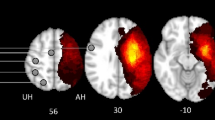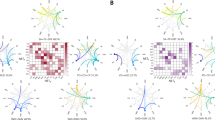Abstract
This study investigated local and global changes in the motor network using longitudinal resting-state functional magnetic resonance imaging (rs-fMRI). Motor impairment was measured in 81 stroke patients using Fugl-Meyer assessment on the same day as rs-fMRI acquisition at both 2 weeks and 3 months post-stroke. The relationships between network measures and motor function scores were assessed. With regard to local connectivity, interhemispheric connectivity was noticeably altered at each time point. Interhemispheric connectivity was also related to residual motor function and improvement in motor function. The anterior intraparietal sulcus and other well-known primary and secondary motor-related regions played important roles in motor function. Changes in global connectivity according to stroke type and initial severity were investigated. In global connectivity, interhemispheric connectivity was disrupted at 2 weeks post-stroke regardless of stroke type and initial severity. During the recovery period, interhemispheric connectivity recovered well in patients with hemorrhagic stroke or low severity. In contrast, there were no significant between-group and within-group alterations in intrahemispheric connectivity. Intrahemispheric connectivity of the inferior frontal cortex (IFC) exhibited opposite alterations compared to other connections. There were no differences between groups in IFC connectivity alterations; however, decreasing ipsilesional IFC connectivity and contralesional IFC during recovery were noticeable in patients with mild to moderate impairments and patients with severe impairments, respectively. These results may be helpful in understanding the network changes that occur after stroke and could have important implications for treatment strategy development in future studies.




Similar content being viewed by others
References
Bledowski C, Prvulovic D, Goebel R, Zanella FE, Linden DE (2004) Attentional systems in target and distractor processing: a combined ERP and fMRI study. Neuroimage 22:530–540
Buetefisch CM (2015) Role of the contralesional hemisphere in post-stroke recovery of upper extremity motor function. Front Neurol 6:214
Bullmore E, Sporns O (2012) The economy of brain network organization. Nat Rev Neurosci 13:336–349
Buma FE, Lindeman E, Ramsey NF, Kwakkel G (2010) Functional neuroimaging studies of early upper limb recovery after stroke: a systematic review of the literature. Neurorehabilit Neural Repair 24:589–608
Carey LM et al (2013) Beyond the lesion: neuroimaging foundations for post-stroke recovery. Future Neurol 8:507–527
Carter AR et al (2010) Resting interhemispheric functional magnetic resonance imaging connectivity predicts performance after stroke. Ann Neurol 67:365–375. https://doi.org/10.1002/ana.21905
Chen X et al (2015) An ischemic stroke model of nonhuman primates for remote lesion studies: a behavioral and neuroimaging investigation. Restor Neurol Neurosci 33:131–142
Corbetta M, Shulman GL (2002) Control of goal-directed and stimulus-driven attention in the brain. Nat Rev Neurosci 3:201–215
Corbetta M, Patel G, Shulman GL (2008) The reorienting system of the human brain: from environment to theory of mind. Neuron 58:306–324
Davare M, Montague K, Olivier E, Rothwell JC, Lemon RN (2009) Ventral premotor to primary motor cortical interactions during object-driven grasp in humans. Cortex 45:1050–1057
Davare M, Kraskov A, Rothwell JC, Lemon RN (2011) Interactions between areas of the cortical grasping network. Curr Opin Neurobiol 21:565–570
Deco G, Tononi G, Boly M, Kringelbach ML (2015) Rethinking segregation and integration: contributions of whole-brain modelling. Nat Rev Neurosci 16:430–439
Dodd KC, Nair VA, Prabhakaran V (2017) Role of the contralesional vs. Ipsilesional hemisphere in stroke recovery. Front Hum Neurosci 11:469
Duncan PW, Goldstein LB, Horner RD, Landsman PB, Samsa GP, Matchar DB (1994) Similar motor recovery of upper and lower extremities after stroke. Stroke 25:1181–1188
Ehrsson HH, Fagergren A, Forssberg H (2001) Differential fronto-parietal activation depending on force used in a precision grip task: an fMRI study. J Neurophysiol 85:2613–2623
Fugl-Meyer AR, Jääskö L, Leyman I, Olsson S, Steglind S (1974) The post-stroke hemiplegic patient. 1. a method for evaluation of physical performance. Scand J Rehabil Med 7:13–31
Gratton C, Nomura EM, Pérez F, D’Esposito M (2012) Focal brain lesions to critical locations cause widespread disruption of the modular organization of the brain. J Cogn Neurosci 24:1275–1285
He BJ, Shulman GL, Snyder AZ, Corbetta M (2007a) The role of impaired neuronal communication in neurological disorders. Curr Opin Neurol 20:655–660
He BJ, Snyder AZ, Vincent JL, Epstein A, Shulman GL, Corbetta M (2007b) Breakdown of functional connectivity in frontoparietal networks underlies behavioral deficits in spatial neglect. Neuron 53:905–918
Honey CJ, Sporns O (2008) Dynamical consequences of lesions in cortical networks. Hum Brain Mapp 29:802–809. https://doi.org/10.1002/hbm.20579
Koch G et al (2010) In vivo definition of parieto-motor connections involved in planning of grasping movements. Neuroimage 51:300–312
Lee J, Park E, Lee A, Chang WH, Kim DS, Kim YH (2017) Recovery-related indicators of motor network plasticity according to impairment severity after stroke. Eur J Neurol 24:1290–1299. https://doi.org/10.1111/ene.13377
Linden DE, Prvulovic D, Formisano E, Völlinger M, Zanella FE, Goebel R, Dierks T (1999) The functional neuroanatomy of target detection: an fMRI study of visual and auditory oddball tasks. Cereb Cortex 9:815–823
Olivier E, Davare M, Andres M, Fadiga L (2007) Precision grasping in humans: from motor control to cognition. Curr Opin Neurobiol 17:644–648
Paolucci S et al (2003) Functional outcome of ischemic and hemorrhagic stroke patients after inpatient rehabilitation: a matched comparison. Stroke 34:2861–2865
Park C-h, Chang WH, Ohn SH, Kim ST, Bang OY, Pascual-Leone A, Kim Y-H (2011) Longitudinal changes of resting-state functional connectivity during motor recovery after stroke. Stroke 42:1357–1362
Perna R, Temple J (2015) Rehabilitation outcomes: ischemic versus hemorrhagic strokes. Behav Neurol 2015:1–6
Rehme AK, Grefkes C (2013) Cerebral network disorders after stroke: evidence from imaging-based connectivity analyses of active and resting brain states in humans. J Physiol 591:17–31
Rehme AK, Fink GR, von Cramon DY, Grefkes C (2010) The role of the contralesional motor cortex for motor recovery in the early days after stroke assessed with longitudinal FMRI. Cereb Cortex 21:756–768
Rehme AK, Eickhoff SB, Rottschy C, Fink GR, Grefkes C (2012) Activation likelihood estimation meta-analysis of motor-related neural activity after stroke. Neuroimage 59:2771–2782
Reichenbach A, Bresciani J-P, Peer A, Bülthoff HH, Thielscher A (2010) Contributions of the PPC to online control of visually guided reaching movements assessed with fMRI-guided TMS. Cereb Cortex 21:1602–1612
Schaechter JD, Perdue KL, Wang R (2008) Structural damage to the corticospinal tract correlates with bilateral sensorimotor cortex reorganization in stroke patients. Neuroimage 39:1370–1382
Schepers VP, Ketelaar M, Visser-Meily AJ, de Groot V, Twisk JW, Lindeman E (2008) Functional recovery differs between ischaemic and haemorrhagic stroke patients. J Rehabil Med 40:487–489
Schulz R et al (2015) Parietofrontal motor pathways and their association with motor function after stroke. Brain 138:1949–1960
Siegel JS et al (2016) Disruptions of network connectivity predict impairment in multiple behavioral domains after stroke. Proc Natl Acad Sci USA 113:E4367–E4376
Sporns O (2013) Network attributes for segregation and integration in the human brain. Curr Opin Neurobiol 23:162–171
Stinear CM, Barber PA, Smale PR, Coxon JP, Fleming MK, Byblow WD (2007) Functional potential in chronic stroke patients depends on corticospinal tract integrity. Brain 130:170–180
Tononi G, Sporns O, Edelman GM (1994) A measure for brain complexity: relating functional segregation and integration in the nervous system. Proc Natl Acad Sci USA 91:5033–5037
Tunik E, Frey SH, Grafton ST (2005) Virtual lesions of the anterior intraparietal area disrupt goal-dependent on-line adjustments of grasp. Nat Neurosci 8:505–511
van Meer MP et al (2012) Extent of bilateral neuronal network reorganization and functional recovery in relation to stroke severity. J Neurosci 32:4495–4507
Wang L et al (2010) Dynamic functional reorganization of the motor execution network after stroke. Brain 133:1224–1238. https://doi.org/10.1093/brain/awq043
Ward NS et al (2006) Motor system activation after subcortical stroke depends on corticospinal system integrity. Brain 129:809–819
Westlake KP et al (2012) Resting state alpha-band functional connectivity and recovery after stroke. Exp Neurol 237:160–169
Acknowledgements
This study was supported by a National Research Foundation of Korea (NRF) Grant funded by the Korean government (MSIP, NRF-2017R1A2A1A05000730; MSIT, NRF-2017M3A9G5083690; NRF-2017R1D1A1B03034109).
Author information
Authors and Affiliations
Corresponding author
Ethics declarations
Conflict of interest
The authors declare that this research was conducted in the absence of any commercial or financial relationships that could be construed as a potential conflict of interest.
Additional information
Handling Editor: Christoph M. Michel.
Electronic supplementary material
Below is the link to the electronic supplementary material.
Rights and permissions
About this article
Cite this article
Lee, J., Park, E., Lee, A. et al. Alteration and Role of Interhemispheric and Intrahemispheric Connectivity in Motor Network After Stroke. Brain Topogr 31, 708–719 (2018). https://doi.org/10.1007/s10548-018-0644-9
Received:
Accepted:
Published:
Issue Date:
DOI: https://doi.org/10.1007/s10548-018-0644-9




